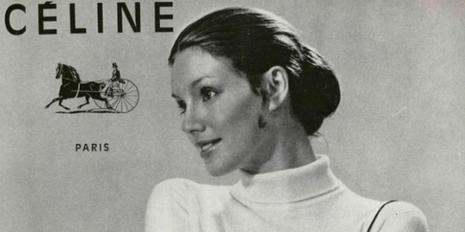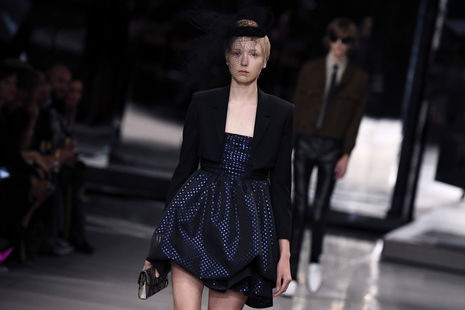Celine: Minimalism to Saint Laurent Replica?

It is January 2018 and Hedi Slimane has just been announced as Celine’s new creative director, ending Phoebe Philo’s pivotal era at Celine. A change of creative director is perfectly natural within the fashion industry, and every major fashion house has had countless creative directors throughout the years. But the shift from Philo to Slimane meant so much more.
Celine was founded in 1945 by Céline Vipiana and was originally a children’s shoe boutique. A decade of success later, Vipiana expanded into ready-to-wear, aiming to provide fashion for the everyday contemporary woman. She launched a sportswear-driven line that was practical, with wool skirt suits and fitted shirts. The brand became globally successful by the 1970s, and Vipiana continued to design new collections up until her death in 1997. She was immediately succeeded by Michael Kors as he brought in new accessible styles to the brand and introduced the classic Boogie and Poulbot ‘it’ bags. Yet in 2004, the buzz died down for Kors as he left to focus on his own brand accusing the parent company LVMH of neglecting him. Kors said in an interview about his departure from the company, ‘Was I mistreated? No. Was I neglected? Yes’.

After an antagonistic era, Celine went through a series of short stints with designers up until 2008 failing to bring the fashion house back into the limelight. The true turning point was Phoebe Philo’s appointment as creative director: a truly monumental move for the brand. Philo’s innovations swiftly turned the company around, streamlining Vipiana’s original aesthetic into a new minimalist framework.
Celine emerged as a new fashion house with collections designed exclusively by women for women. Philo created clothes every woman could walk out and feel confident in, elegantly complementing the female figure without straying into objectification. This feels crucial in the face of a male-dominated fashion industry capitalising on femininity. Philo perfectly predicted what fashionable women needed, impeccably combining practical yet beautiful minimalism for an innovative ‘Celine’ style.
“This feels crucial in the face of a male dominated fashion industry capitalising femininity”
Fast forward to now and Hedi Slimane has taken over as creative director of Celine. As a photographer and designer born in France, Hedi Slimane approaches fashion from many angles. Slimane doesn’t just design the clothes but he designed the stores and photographed the advert campaigns. Having previously worked as creative director for Yves Saint Laurent, Slimane had already reshaped Saint Laurent into his image: a sharp, skinny silhouette. He worked wonders for the brand, revamping the look into something which appealed massively to a younger audience. However, his recent move to Celine has been far more tumultuous.

Slimane’s work appeared to be lazy. The models walked out in tight fitting short skirts merely mimicking the skinny figure Slimane made his staple at Yves Saint Laurent. Celine was the driving force of minimalistic clean lines, yet Slimane made no effort to continue on Celine’s culture of making clothing which uniquely empowers women. The collection felt like a weak carbon copy of the Yves Saint Laurent show, stripping Celine of its original identity.
This may seem harsh judgement given every creative director must have time to settle into their new position, and so I was willing to reserve judgement in the hopes Celine would be revived once more. Yet collections have gone by and still no hope of Celine being restored to its former feminist glory. Celine has lost its identity and Slimane is too lazy to find it. From a brand so perfectly made by women for women to one led by a man praised for regurgitating his same work over and over again, it feels like so much more than just the loss of a brand but the loss of the voice Celine gave to women. It requires a perceptiveness and willingness to adapt one’s own style, which Slimane has fallen short of. All we can hope for now is that the next creative director revives the era of Phoebe Philo, pushing Celine back into the territory of daring, important fashion design.
 Comment / Plastic pubs: the problem with Cambridge alehouses 5 January 2026
Comment / Plastic pubs: the problem with Cambridge alehouses 5 January 2026 News / Cambridge businesses concerned infrastructure delays will hurt growth5 January 2026
News / Cambridge businesses concerned infrastructure delays will hurt growth5 January 2026 News / New movement ‘Cambridge is Chopped’ launched to fight against hate crime7 January 2026
News / New movement ‘Cambridge is Chopped’ launched to fight against hate crime7 January 2026 News / AstraZeneca sues for £32 million over faulty construction at Cambridge Campus31 December 2025
News / AstraZeneca sues for £32 million over faulty construction at Cambridge Campus31 December 2025 News / Uni-linked firms rank among Cambridgeshire’s largest7 January 2026
News / Uni-linked firms rank among Cambridgeshire’s largest7 January 2026









